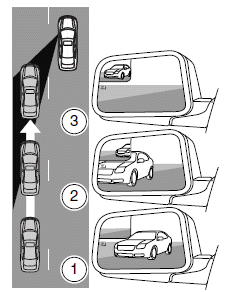Blind spot mirrors (if equipped)

Blind spot mirrors have an integrated convex spotter mirror built into the upper outboard corner of the outside mirrors. They are designed to assist the driver by increasing visibility along the side of the vehicle. For more information on your side view mirrors, refer to Exterior mirrors in the Driver Controls chapter.
Driving with blind spot mirrors
Before a lane change, check the main mirror first, then check the blind spot mirror. If no vehicles are present in the blind spot mirror and the traffic in the adjacent lane is at a safe distance, signal that you are going to change lanes. Glance over your shoulder to verify traffic is clear, and carefully change lanes.
When the approaching vehicle is at a distance, its image is small and near the inboard edge of the main mirror. As the vehicle approaches, the image becomes larger and begins to move outboard across the main mirror (1). As the vehicle approaches its image will transition from the main mirror and begin to appear in the blind spot mirror (2).
As the vehicle leaves the blind spot mirror it will transition to the driverТs peripheral field of view (3).

WARNING: Objects in the blind spot mirror are closer than they appear.
See also:
Brake fluid
The fluid level will drop slowly as
the brakes wear, and will rise when
the brake components are replaced.
Fluid levels between the MIN and
MAX lines are within the normal
operating range; ...
Children and airbags
Children must always be properly
restrained. Accident statistics
suggest that children are safer when
properly restrained in the rear
seating positions than in the front
seating position. Fa ...
Autolock feature (if enabled)
The autolock feature will lock all the doors when:
Х all the doors are closed
Х the ignition is on,
Х you shift into any gear putting the vehicle in motion, and
Х the vehicle attains a speed ...
